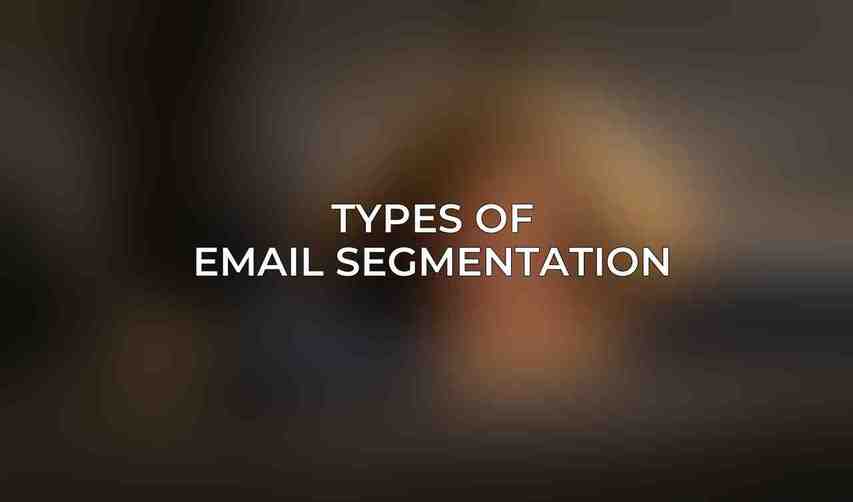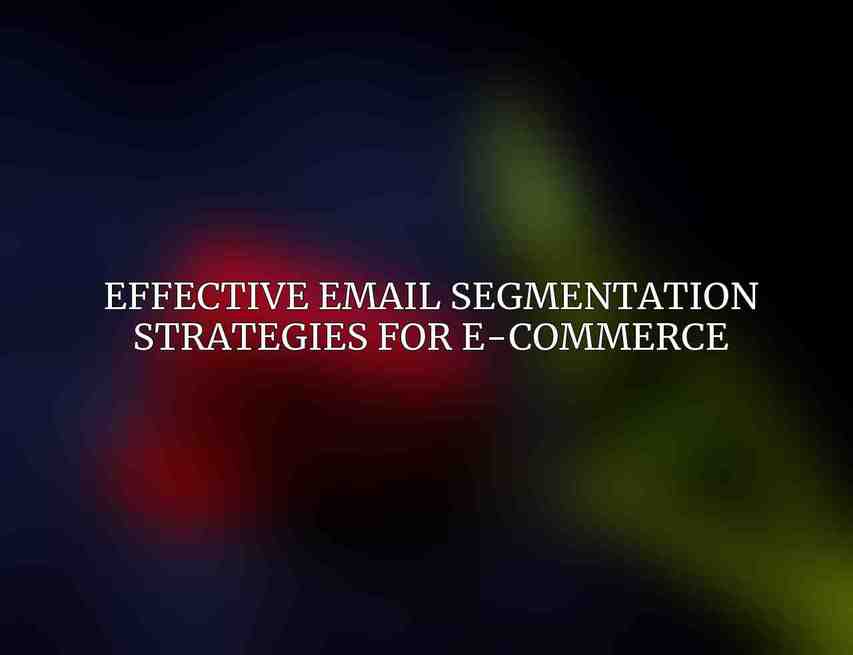Email segmentation is a crucial marketing strategy that involves dividing your email list into smaller, targeted segments based on specific criteria such as demographics, behavior, or psychographics. This approach allows e-commerce businesses to send personalized and relevant content to different groups of customers. The benefits of email segmentation for e-commerce are substantial, including increased open rates, higher click-through rates, improved conversion rates, and enhanced customer loyalty. By delivering content that resonates with each segment, businesses can nurture stronger relationships with their customers, leading to improved engagement and sales.
Types of Email Segmentation

Demographic Segmentation:
Demographic segmentation involves categorizing customers based on characteristics like age, gender, and location. By tailoring email content to suit these demographics, e-commerce businesses can create more personalized marketing campaigns that resonate with their target audience. For example, segmenting customers by age allows businesses to customize their messaging to appeal to different age groups, such as millennials, Gen Z, or seniors.
| Demographic | Segmentation |
|---|---|
| Age | Millennials, Gen Z, Seniors |
| Gender | Male, Female, Non-binary |
| Location | Country, State, City |
Behavioral Segmentation:
Behavioral segmentation involves dividing customers based on their actions and interactions with the brand. By segmenting customers by their purchase history, engagement levels with emails, and website behavior, e-commerce businesses can deliver targeted content that aligns with customers’ past interactions with the brand. This personalized approach can significantly improve the relevance and effectiveness of email campaigns.
| Behavioral | Segmentation |
|---|---|
| Purchase History | Past purchases, Products bought, Categories |
| Engagement History | Open rates, Click-through rates, Email frequency |
| Website Behavior | Pages visited, Time spent on site, Cart items |
Psychographic Segmentation:
Psychographic segmentation involves understanding customers based on their interests, values, and lifestyle choices. By segmenting customers according to their hobbies, values, or preferences, e-commerce businesses can create content that resonates with their customers on a deeper level, fostering stronger connections and brand loyalty.
| Psychographic | Segmentation |
|---|---|
| Interests | Hobbies, Passions, Lifestyle Preferences |
| Values | Environmental consciousness, Ethical shopping, Social justice |
Best Practices for Email Segmentation

Effective email segmentation starts with setting clear objectives for your campaigns. Whether you aim to increase sales, generate leads, or boost customer engagement, defining your goals will guide your segmentation strategy. Collecting relevant data from sources like your e-commerce platform, CRM system, and social media is crucial for creating meaningful customer segments.
To create precise and impactful segments, it’s essential to use multiple criteria such as demographics, behavior, and psychographics. Testing and refining your segments regularly based on performance insights will help optimize the effectiveness of your email campaigns.
Effective Email Segmentation Campaigns
Welcome Series:
A well-crafted welcome series is a great way to introduce new subscribers to your brand. By sending personalized welcome emails and follow-up messages tailored to their interests, you can make a positive first impression and start building a relationship with your customers from the get-go.
Product Recommendations:
Utilize customers’ purchase history and browsing behavior to send personalized product recommendations. By recommending products that align with customers’ preferences and past purchases, you can increase the chances of conversion and drive sales.
Abandoned Cart Recovery:
Implement automated emails to remind customers about items left in their cart and encourage them to complete their purchase. Abandoned cart recovery emails have proven to be effective in recovering lost sales and re-engaging customers who showed interest in your products.
Anniversary and Birthday Campaigns:
Celebrate special occasions with your customers by sending them personalized offers or discounts on their anniversary or birthday. These campaigns enhance customer loyalty and encourage repeat purchases.
Targeted Promotions:
Create targeted promotions and discounts based on customers’ demographics, behavior, or psychographics. By offering tailored incentives, you can entice customers to make a purchase and drive revenue for your e-commerce business.
Measurement and Analysis
To gauge the success of your email segmentation campaigns, it’s crucial to track key metrics such as open rates, click-through rates, conversion rates, and customer lifetime value. Leveraging marketing automation tools can streamline the segmentation process and provide valuable insights into campaign performance.
Regularly analyzing the performance of each segment allows you to identify areas for improvement and refine your strategies for future campaigns. By staying informed about how your segments are performing, you can continuously optimize your email marketing efforts to maximize engagement and conversions.
effective email segmentation is a powerful tool for e-commerce businesses looking to enhance their marketing strategies and drive meaningful results. By understanding the different types of segmentation, implementing best practices, and creating targeted campaigns, businesses can nurture stronger relationships with customers and boost their bottom line.
Remember, as the digital world continues to evolve, staying ahead with personalized and relevant email campaigns through segmentation will be key to standing out in a crowded e-commerce market. Dive deeper into Top Email Marketing Best Practices for E-Commerce Growth
By incorporating email segmentation best practices, e-commerce businesses can build stronger connections with their customers and drive improved engagement and sales. Check out Mailchimp’s guide for a comprehensive overview of email segmentation strategies and implementation tips.
Frequently Asked Questions
What is email segmentation?
Email segmentation is the practice of dividing your email list into smaller groups or segments based on specific criteria such as demographics, purchase history, engagement levels, or preferences. You can find more information on How to Craft The Perfect E-Commerce Marketing Email
Why is email segmentation important for e-commerce?
Email segmentation allows e-commerce businesses to send more relevant and personalized messages to their customers, leading to higher open rates, click-through rates, and ultimately, better conversion rates.
How can I segment my email list effectively?
To segment your email list effectively, you can use criteria such as customer behavior, interests, demographics, purchase history, location, or engagement levels. Use an email marketing platform that offers robust segmentation tools.
What are some common segmentation strategies for e-commerce emails?
Some common segmentation strategies for e-commerce emails include sending targeted emails based on past purchases, promoting products related to customers’ browsing behavior, re-engaging inactive subscribers, and sending personalized recommendations based on customer preferences.
How can I measure the success of my email segmentation efforts?
You can measure the success of your email segmentation efforts by tracking key metrics such as open rates, click-through rates, conversion rates, revenue generated, and customer engagement. Use A/B testing to compare the performance of different segments and optimize your email campaigns.

